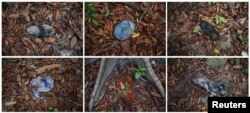It's a one-hour trek through thick jungle from the nearest road to the ramshackle camp along Malaysia's northern border, but for all its remoteness this was a perfect setting for human traffickers to ply their grisly trade.
Prisoners could be kept alive with water from a stream running through the gully where the now-abandoned camp was nestled and, thanks to a good mobile phone signal from Thailand, they could communicate with accomplices across a trafficking supply chain that begins in Bangladesh and Myanmar.
There was a faint smell of decomposition on the edges of the camp, where Tuesday a Malaysian police forensics team began to dig out bodies of trafficking victims who were buried before their captors fled.
Mass graves
It was painstaking work for the police, who poked gingerly at the damp earth with hoes. The first body exhumed from one of the 37 graves discovered here was shrouded in a cloth. Nearby, what appeared to be a human lower jaw lay in the undergrowth.
Altogether the authorities have found nearly 140 shallow graves at 28 camps strung along the border, some of which they believe were abandoned in haste after Thailand launched a crackdown on people smuggling earlier this month.
The dense forests of southern Thailand and northern Malaysia have been a major staging post for smugglers bringing people to Southeast Asia by boat from Myanmar, most of them Rohingya Muslims who say they are fleeing persecution, and Bangladesh.
In recent years it has been common for them to be held in remote camps like this until a ransom is paid for their freedom.
Journalists were taken by police to the camp on Tuesday, following a steep uphill path littered with clothes and food wrappers that suggested it was a well-trodden route.
As reporters watched the officers dig in sombre silence, evidence abounded that this had been a place of abuse and fear.
Several broken-down bamboo structures raised on stilts appeared to be makeshift prisons, with wire mesh walls and coils of barbed wire. There was a low cage, too small to stand up in, that police believe was used to punish migrants.
Amid the tangle of bamboo and tarpaulin was a large water tank. Police photographs of other camps in the area showed an abandoned generator, makeshift kitchens that could cook for hundreds of people, and evidence that crops were being grown – all signs that the camps had been there some time.
This site, just a few hundred metres from the border with Thailand, could have held up to 400 people, one officer said.
A Muslim call to prayers could be heard from the camp, indicating it was not too far from a village, where the guards may have bought food to keep their prisoners alive.
Thailand areas
The discoveries in Malaysia followed the uncovering of similar graves on the Thai side of the border in early May. That led to a crackdown on the camps by Thailand, after which traffickers abandoned thousands of migrants in overloaded boats that were already en route in the Bay of Bengal and Andaman Sea.
The mood was tense at the site in Malaysia on Tuesday, where watchful police cradled M16 assault rifles.
"You are in a border security area," said Royal Malaysia Police spokeswoman ACP Datin Asmawati. "There are still trafficking activities on the other side."

